Critical Analysis of Management Processes and GM's Challenges
VerifiedAdded on 2023/04/21
|13
|3980
|286
Case Study
AI Summary
This case study provides a critical analysis of General Motors' (GM) management processes and the internal and external challenges that contributed to its decline. It examines issues such as high labor costs due to union contracts, poor product quality and design, and lower productivity compared to Japanese competitors like Toyota. The analysis delves into GM's struggles with adopting Toyota's efficient management practices, including standardized work instructions, employee empowerment, and supply chain management. It highlights the contrast between GM's rigid, top-down management style and Toyota's collaborative approach, which emphasized continuous improvement and employee involvement. The study further explores GM's challenges in supply chain management, characterized by short-term contracts and a lack of collaboration with suppliers, compared to the long-term, trust-based relationships fostered by Japanese automakers. Ultimately, the case study illustrates how a combination of internal inefficiencies, external competitive pressures, and a failure to adapt to changing market conditions led to GM's struggles.

Managing in a challenging environment 1
Managing in a challenging environment
Name
Course
Tutor
University
City/State
Date
Managing in a challenging environment
Name
Course
Tutor
University
City/State
Date
Paraphrase This Document
Need a fresh take? Get an instant paraphrase of this document with our AI Paraphraser
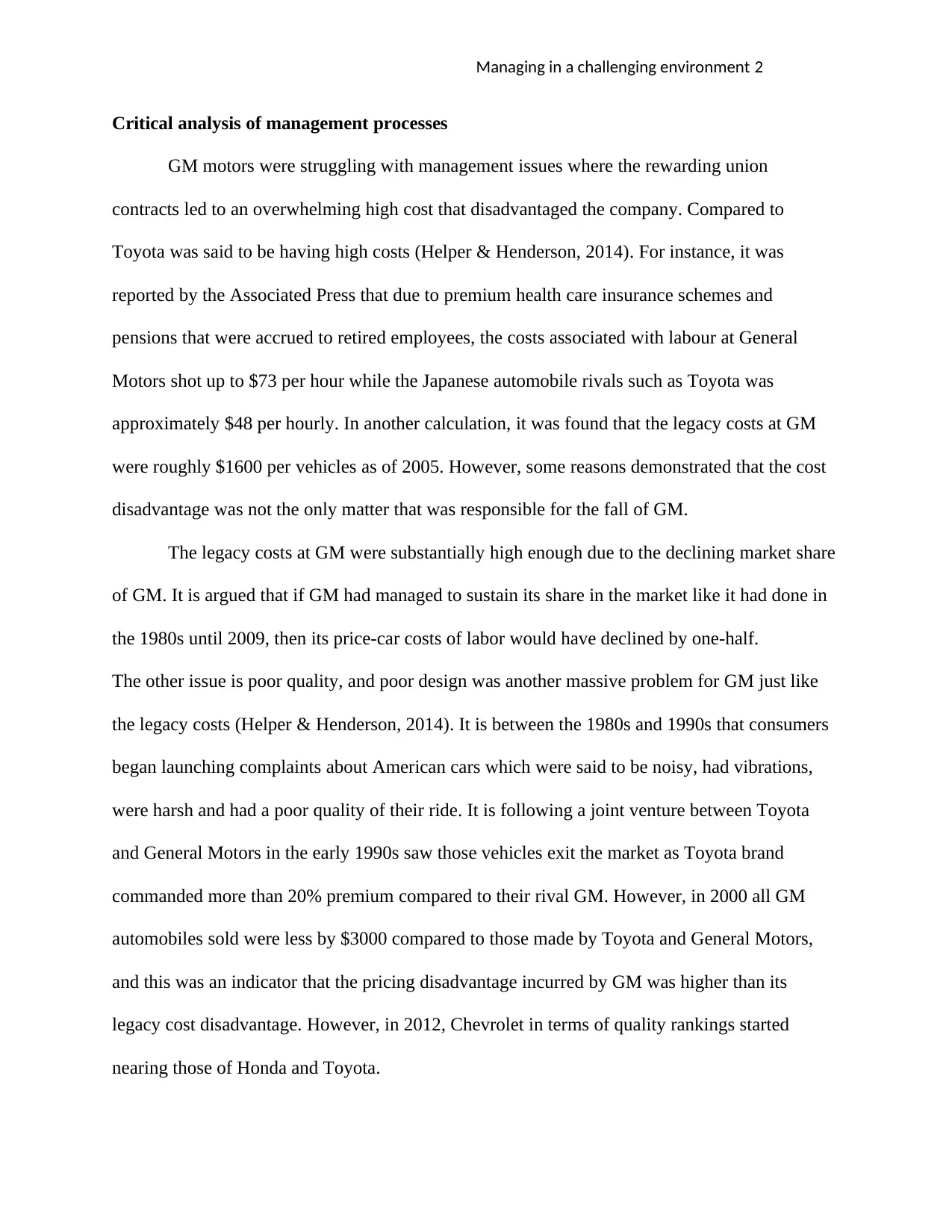
Managing in a challenging environment 2
Critical analysis of management processes
GM motors were struggling with management issues where the rewarding union
contracts led to an overwhelming high cost that disadvantaged the company. Compared to
Toyota was said to be having high costs (Helper & Henderson, 2014). For instance, it was
reported by the Associated Press that due to premium health care insurance schemes and
pensions that were accrued to retired employees, the costs associated with labour at General
Motors shot up to $73 per hour while the Japanese automobile rivals such as Toyota was
approximately $48 per hourly. In another calculation, it was found that the legacy costs at GM
were roughly $1600 per vehicles as of 2005. However, some reasons demonstrated that the cost
disadvantage was not the only matter that was responsible for the fall of GM.
The legacy costs at GM were substantially high enough due to the declining market share
of GM. It is argued that if GM had managed to sustain its share in the market like it had done in
the 1980s until 2009, then its price-car costs of labor would have declined by one-half.
The other issue is poor quality, and poor design was another massive problem for GM just like
the legacy costs (Helper & Henderson, 2014). It is between the 1980s and 1990s that consumers
began launching complaints about American cars which were said to be noisy, had vibrations,
were harsh and had a poor quality of their ride. It is following a joint venture between Toyota
and General Motors in the early 1990s saw those vehicles exit the market as Toyota brand
commanded more than 20% premium compared to their rival GM. However, in 2000 all GM
automobiles sold were less by $3000 compared to those made by Toyota and General Motors,
and this was an indicator that the pricing disadvantage incurred by GM was higher than its
legacy cost disadvantage. However, in 2012, Chevrolet in terms of quality rankings started
nearing those of Honda and Toyota.
Critical analysis of management processes
GM motors were struggling with management issues where the rewarding union
contracts led to an overwhelming high cost that disadvantaged the company. Compared to
Toyota was said to be having high costs (Helper & Henderson, 2014). For instance, it was
reported by the Associated Press that due to premium health care insurance schemes and
pensions that were accrued to retired employees, the costs associated with labour at General
Motors shot up to $73 per hour while the Japanese automobile rivals such as Toyota was
approximately $48 per hourly. In another calculation, it was found that the legacy costs at GM
were roughly $1600 per vehicles as of 2005. However, some reasons demonstrated that the cost
disadvantage was not the only matter that was responsible for the fall of GM.
The legacy costs at GM were substantially high enough due to the declining market share
of GM. It is argued that if GM had managed to sustain its share in the market like it had done in
the 1980s until 2009, then its price-car costs of labor would have declined by one-half.
The other issue is poor quality, and poor design was another massive problem for GM just like
the legacy costs (Helper & Henderson, 2014). It is between the 1980s and 1990s that consumers
began launching complaints about American cars which were said to be noisy, had vibrations,
were harsh and had a poor quality of their ride. It is following a joint venture between Toyota
and General Motors in the early 1990s saw those vehicles exit the market as Toyota brand
commanded more than 20% premium compared to their rival GM. However, in 2000 all GM
automobiles sold were less by $3000 compared to those made by Toyota and General Motors,
and this was an indicator that the pricing disadvantage incurred by GM was higher than its
legacy cost disadvantage. However, in 2012, Chevrolet in terms of quality rankings started
nearing those of Honda and Toyota.
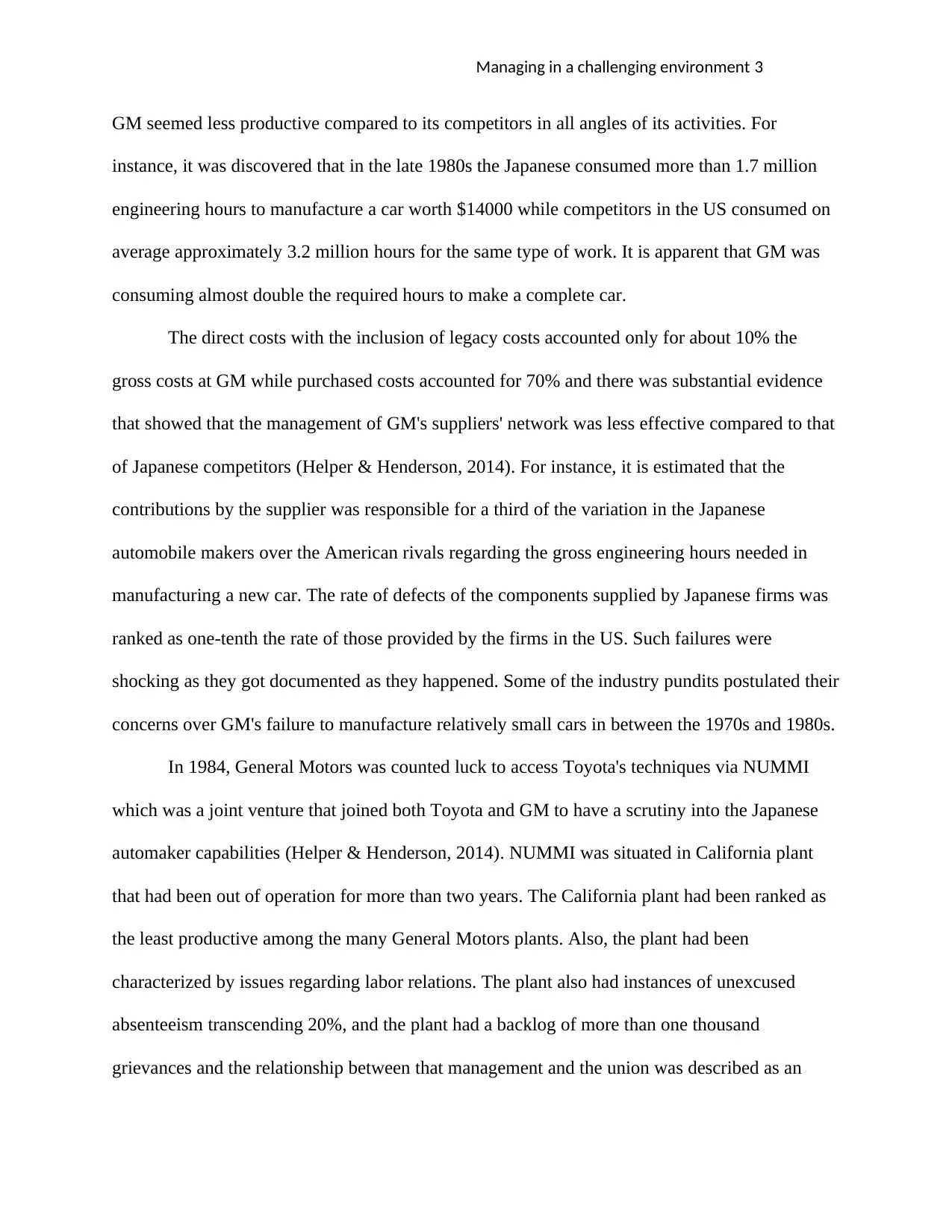
Managing in a challenging environment 3
GM seemed less productive compared to its competitors in all angles of its activities. For
instance, it was discovered that in the late 1980s the Japanese consumed more than 1.7 million
engineering hours to manufacture a car worth $14000 while competitors in the US consumed on
average approximately 3.2 million hours for the same type of work. It is apparent that GM was
consuming almost double the required hours to make a complete car.
The direct costs with the inclusion of legacy costs accounted only for about 10% the
gross costs at GM while purchased costs accounted for 70% and there was substantial evidence
that showed that the management of GM's suppliers' network was less effective compared to that
of Japanese competitors (Helper & Henderson, 2014). For instance, it is estimated that the
contributions by the supplier was responsible for a third of the variation in the Japanese
automobile makers over the American rivals regarding the gross engineering hours needed in
manufacturing a new car. The rate of defects of the components supplied by Japanese firms was
ranked as one-tenth the rate of those provided by the firms in the US. Such failures were
shocking as they got documented as they happened. Some of the industry pundits postulated their
concerns over GM's failure to manufacture relatively small cars in between the 1970s and 1980s.
In 1984, General Motors was counted luck to access Toyota's techniques via NUMMI
which was a joint venture that joined both Toyota and GM to have a scrutiny into the Japanese
automaker capabilities (Helper & Henderson, 2014). NUMMI was situated in California plant
that had been out of operation for more than two years. The California plant had been ranked as
the least productive among the many General Motors plants. Also, the plant had been
characterized by issues regarding labor relations. The plant also had instances of unexcused
absenteeism transcending 20%, and the plant had a backlog of more than one thousand
grievances and the relationship between that management and the union was described as an
GM seemed less productive compared to its competitors in all angles of its activities. For
instance, it was discovered that in the late 1980s the Japanese consumed more than 1.7 million
engineering hours to manufacture a car worth $14000 while competitors in the US consumed on
average approximately 3.2 million hours for the same type of work. It is apparent that GM was
consuming almost double the required hours to make a complete car.
The direct costs with the inclusion of legacy costs accounted only for about 10% the
gross costs at GM while purchased costs accounted for 70% and there was substantial evidence
that showed that the management of GM's suppliers' network was less effective compared to that
of Japanese competitors (Helper & Henderson, 2014). For instance, it is estimated that the
contributions by the supplier was responsible for a third of the variation in the Japanese
automobile makers over the American rivals regarding the gross engineering hours needed in
manufacturing a new car. The rate of defects of the components supplied by Japanese firms was
ranked as one-tenth the rate of those provided by the firms in the US. Such failures were
shocking as they got documented as they happened. Some of the industry pundits postulated their
concerns over GM's failure to manufacture relatively small cars in between the 1970s and 1980s.
In 1984, General Motors was counted luck to access Toyota's techniques via NUMMI
which was a joint venture that joined both Toyota and GM to have a scrutiny into the Japanese
automaker capabilities (Helper & Henderson, 2014). NUMMI was situated in California plant
that had been out of operation for more than two years. The California plant had been ranked as
the least productive among the many General Motors plants. Also, the plant had been
characterized by issues regarding labor relations. The plant also had instances of unexcused
absenteeism transcending 20%, and the plant had a backlog of more than one thousand
grievances and the relationship between that management and the union was described as an
⊘ This is a preview!⊘
Do you want full access?
Subscribe today to unlock all pages.

Trusted by 1+ million students worldwide
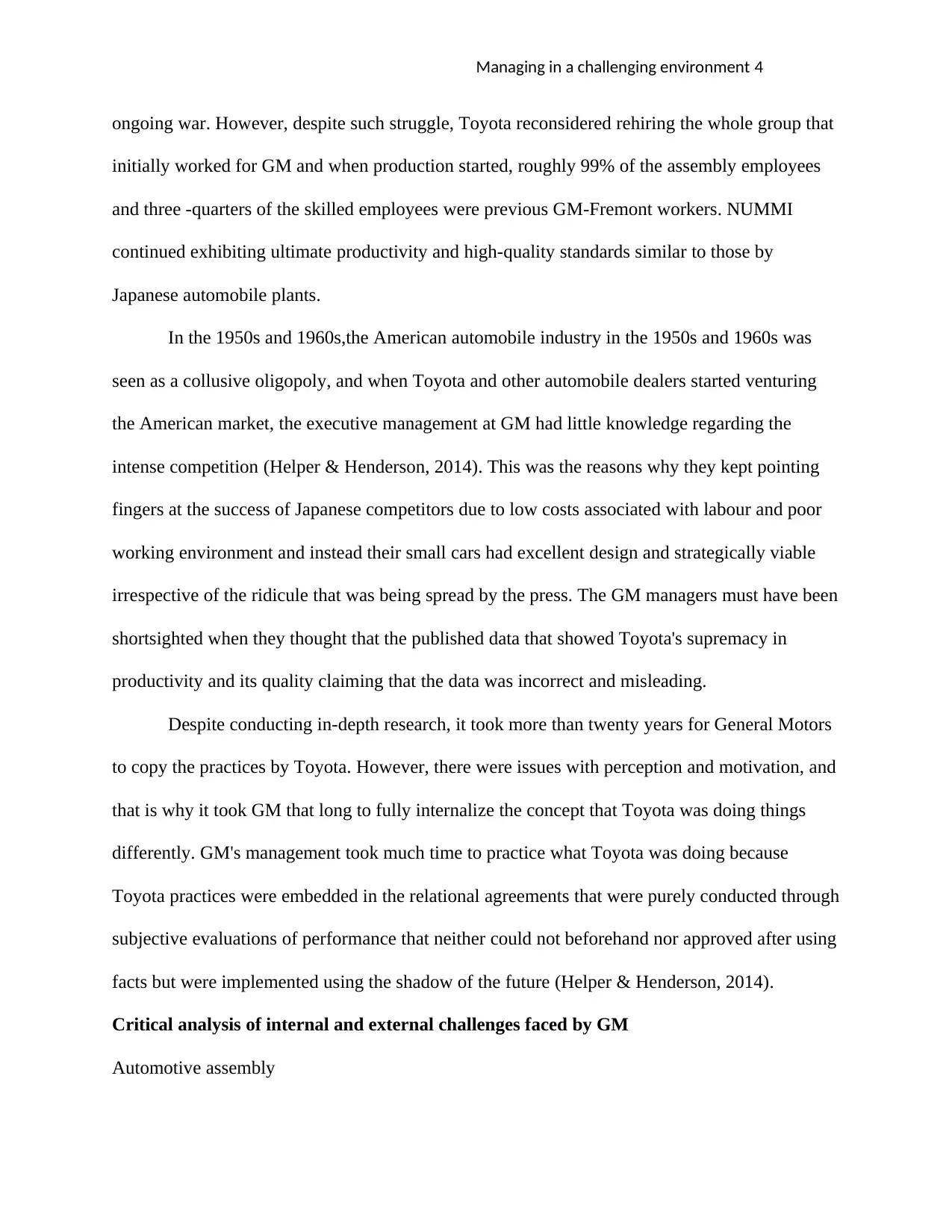
Managing in a challenging environment 4
ongoing war. However, despite such struggle, Toyota reconsidered rehiring the whole group that
initially worked for GM and when production started, roughly 99% of the assembly employees
and three -quarters of the skilled employees were previous GM-Fremont workers. NUMMI
continued exhibiting ultimate productivity and high-quality standards similar to those by
Japanese automobile plants.
In the 1950s and 1960s,the American automobile industry in the 1950s and 1960s was
seen as a collusive oligopoly, and when Toyota and other automobile dealers started venturing
the American market, the executive management at GM had little knowledge regarding the
intense competition (Helper & Henderson, 2014). This was the reasons why they kept pointing
fingers at the success of Japanese competitors due to low costs associated with labour and poor
working environment and instead their small cars had excellent design and strategically viable
irrespective of the ridicule that was being spread by the press. The GM managers must have been
shortsighted when they thought that the published data that showed Toyota's supremacy in
productivity and its quality claiming that the data was incorrect and misleading.
Despite conducting in-depth research, it took more than twenty years for General Motors
to copy the practices by Toyota. However, there were issues with perception and motivation, and
that is why it took GM that long to fully internalize the concept that Toyota was doing things
differently. GM's management took much time to practice what Toyota was doing because
Toyota practices were embedded in the relational agreements that were purely conducted through
subjective evaluations of performance that neither could not beforehand nor approved after using
facts but were implemented using the shadow of the future (Helper & Henderson, 2014).
Critical analysis of internal and external challenges faced by GM
Automotive assembly
ongoing war. However, despite such struggle, Toyota reconsidered rehiring the whole group that
initially worked for GM and when production started, roughly 99% of the assembly employees
and three -quarters of the skilled employees were previous GM-Fremont workers. NUMMI
continued exhibiting ultimate productivity and high-quality standards similar to those by
Japanese automobile plants.
In the 1950s and 1960s,the American automobile industry in the 1950s and 1960s was
seen as a collusive oligopoly, and when Toyota and other automobile dealers started venturing
the American market, the executive management at GM had little knowledge regarding the
intense competition (Helper & Henderson, 2014). This was the reasons why they kept pointing
fingers at the success of Japanese competitors due to low costs associated with labour and poor
working environment and instead their small cars had excellent design and strategically viable
irrespective of the ridicule that was being spread by the press. The GM managers must have been
shortsighted when they thought that the published data that showed Toyota's supremacy in
productivity and its quality claiming that the data was incorrect and misleading.
Despite conducting in-depth research, it took more than twenty years for General Motors
to copy the practices by Toyota. However, there were issues with perception and motivation, and
that is why it took GM that long to fully internalize the concept that Toyota was doing things
differently. GM's management took much time to practice what Toyota was doing because
Toyota practices were embedded in the relational agreements that were purely conducted through
subjective evaluations of performance that neither could not beforehand nor approved after using
facts but were implemented using the shadow of the future (Helper & Henderson, 2014).
Critical analysis of internal and external challenges faced by GM
Automotive assembly
Paraphrase This Document
Need a fresh take? Get an instant paraphrase of this document with our AI Paraphraser
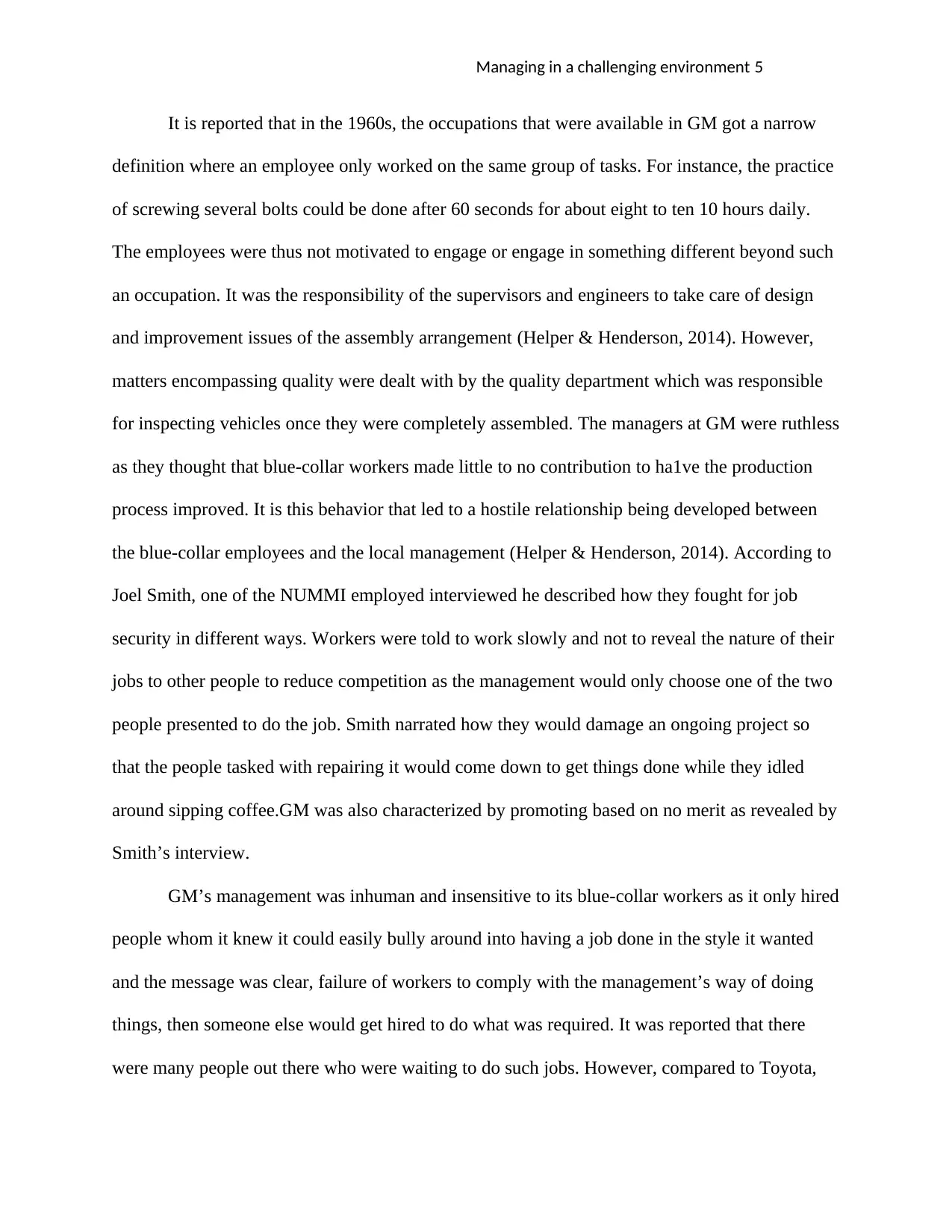
Managing in a challenging environment 5
It is reported that in the 1960s, the occupations that were available in GM got a narrow
definition where an employee only worked on the same group of tasks. For instance, the practice
of screwing several bolts could be done after 60 seconds for about eight to ten 10 hours daily.
The employees were thus not motivated to engage or engage in something different beyond such
an occupation. It was the responsibility of the supervisors and engineers to take care of design
and improvement issues of the assembly arrangement (Helper & Henderson, 2014). However,
matters encompassing quality were dealt with by the quality department which was responsible
for inspecting vehicles once they were completely assembled. The managers at GM were ruthless
as they thought that blue-collar workers made little to no contribution to ha1ve the production
process improved. It is this behavior that led to a hostile relationship being developed between
the blue-collar employees and the local management (Helper & Henderson, 2014). According to
Joel Smith, one of the NUMMI employed interviewed he described how they fought for job
security in different ways. Workers were told to work slowly and not to reveal the nature of their
jobs to other people to reduce competition as the management would only choose one of the two
people presented to do the job. Smith narrated how they would damage an ongoing project so
that the people tasked with repairing it would come down to get things done while they idled
around sipping coffee.GM was also characterized by promoting based on no merit as revealed by
Smith’s interview.
GM’s management was inhuman and insensitive to its blue-collar workers as it only hired
people whom it knew it could easily bully around into having a job done in the style it wanted
and the message was clear, failure of workers to comply with the management’s way of doing
things, then someone else would get hired to do what was required. It was reported that there
were many people out there who were waiting to do such jobs. However, compared to Toyota,
It is reported that in the 1960s, the occupations that were available in GM got a narrow
definition where an employee only worked on the same group of tasks. For instance, the practice
of screwing several bolts could be done after 60 seconds for about eight to ten 10 hours daily.
The employees were thus not motivated to engage or engage in something different beyond such
an occupation. It was the responsibility of the supervisors and engineers to take care of design
and improvement issues of the assembly arrangement (Helper & Henderson, 2014). However,
matters encompassing quality were dealt with by the quality department which was responsible
for inspecting vehicles once they were completely assembled. The managers at GM were ruthless
as they thought that blue-collar workers made little to no contribution to ha1ve the production
process improved. It is this behavior that led to a hostile relationship being developed between
the blue-collar employees and the local management (Helper & Henderson, 2014). According to
Joel Smith, one of the NUMMI employed interviewed he described how they fought for job
security in different ways. Workers were told to work slowly and not to reveal the nature of their
jobs to other people to reduce competition as the management would only choose one of the two
people presented to do the job. Smith narrated how they would damage an ongoing project so
that the people tasked with repairing it would come down to get things done while they idled
around sipping coffee.GM was also characterized by promoting based on no merit as revealed by
Smith’s interview.
GM’s management was inhuman and insensitive to its blue-collar workers as it only hired
people whom it knew it could easily bully around into having a job done in the style it wanted
and the message was clear, failure of workers to comply with the management’s way of doing
things, then someone else would get hired to do what was required. It was reported that there
were many people out there who were waiting to do such jobs. However, compared to Toyota,
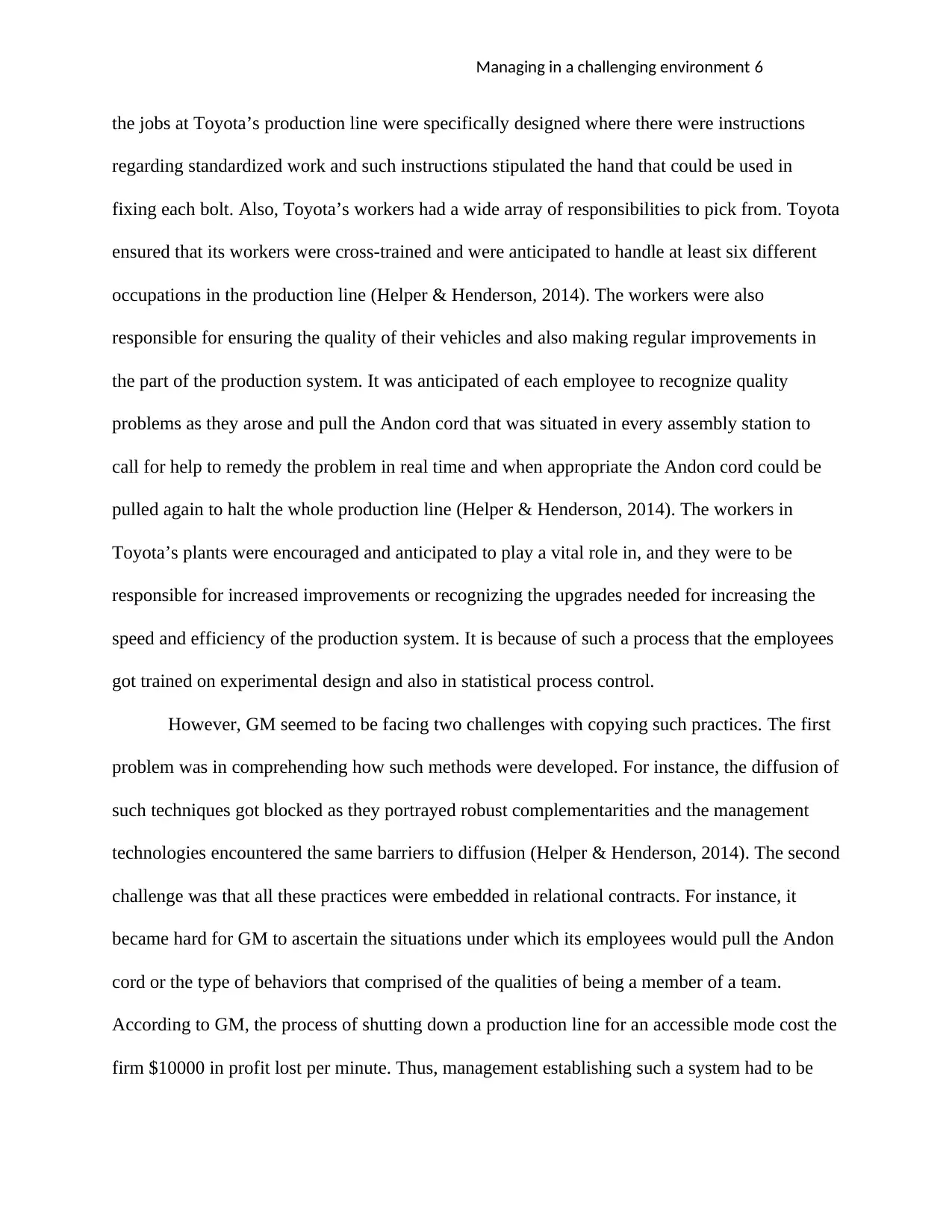
Managing in a challenging environment 6
the jobs at Toyota’s production line were specifically designed where there were instructions
regarding standardized work and such instructions stipulated the hand that could be used in
fixing each bolt. Also, Toyota’s workers had a wide array of responsibilities to pick from. Toyota
ensured that its workers were cross-trained and were anticipated to handle at least six different
occupations in the production line (Helper & Henderson, 2014). The workers were also
responsible for ensuring the quality of their vehicles and also making regular improvements in
the part of the production system. It was anticipated of each employee to recognize quality
problems as they arose and pull the Andon cord that was situated in every assembly station to
call for help to remedy the problem in real time and when appropriate the Andon cord could be
pulled again to halt the whole production line (Helper & Henderson, 2014). The workers in
Toyota’s plants were encouraged and anticipated to play a vital role in, and they were to be
responsible for increased improvements or recognizing the upgrades needed for increasing the
speed and efficiency of the production system. It is because of such a process that the employees
got trained on experimental design and also in statistical process control.
However, GM seemed to be facing two challenges with copying such practices. The first
problem was in comprehending how such methods were developed. For instance, the diffusion of
such techniques got blocked as they portrayed robust complementarities and the management
technologies encountered the same barriers to diffusion (Helper & Henderson, 2014). The second
challenge was that all these practices were embedded in relational contracts. For instance, it
became hard for GM to ascertain the situations under which its employees would pull the Andon
cord or the type of behaviors that comprised of the qualities of being a member of a team.
According to GM, the process of shutting down a production line for an accessible mode cost the
firm $10000 in profit lost per minute. Thus, management establishing such a system had to be
the jobs at Toyota’s production line were specifically designed where there were instructions
regarding standardized work and such instructions stipulated the hand that could be used in
fixing each bolt. Also, Toyota’s workers had a wide array of responsibilities to pick from. Toyota
ensured that its workers were cross-trained and were anticipated to handle at least six different
occupations in the production line (Helper & Henderson, 2014). The workers were also
responsible for ensuring the quality of their vehicles and also making regular improvements in
the part of the production system. It was anticipated of each employee to recognize quality
problems as they arose and pull the Andon cord that was situated in every assembly station to
call for help to remedy the problem in real time and when appropriate the Andon cord could be
pulled again to halt the whole production line (Helper & Henderson, 2014). The workers in
Toyota’s plants were encouraged and anticipated to play a vital role in, and they were to be
responsible for increased improvements or recognizing the upgrades needed for increasing the
speed and efficiency of the production system. It is because of such a process that the employees
got trained on experimental design and also in statistical process control.
However, GM seemed to be facing two challenges with copying such practices. The first
problem was in comprehending how such methods were developed. For instance, the diffusion of
such techniques got blocked as they portrayed robust complementarities and the management
technologies encountered the same barriers to diffusion (Helper & Henderson, 2014). The second
challenge was that all these practices were embedded in relational contracts. For instance, it
became hard for GM to ascertain the situations under which its employees would pull the Andon
cord or the type of behaviors that comprised of the qualities of being a member of a team.
According to GM, the process of shutting down a production line for an accessible mode cost the
firm $10000 in profit lost per minute. Thus, management establishing such a system had to be
⊘ This is a preview!⊘
Do you want full access?
Subscribe today to unlock all pages.

Trusted by 1+ million students worldwide
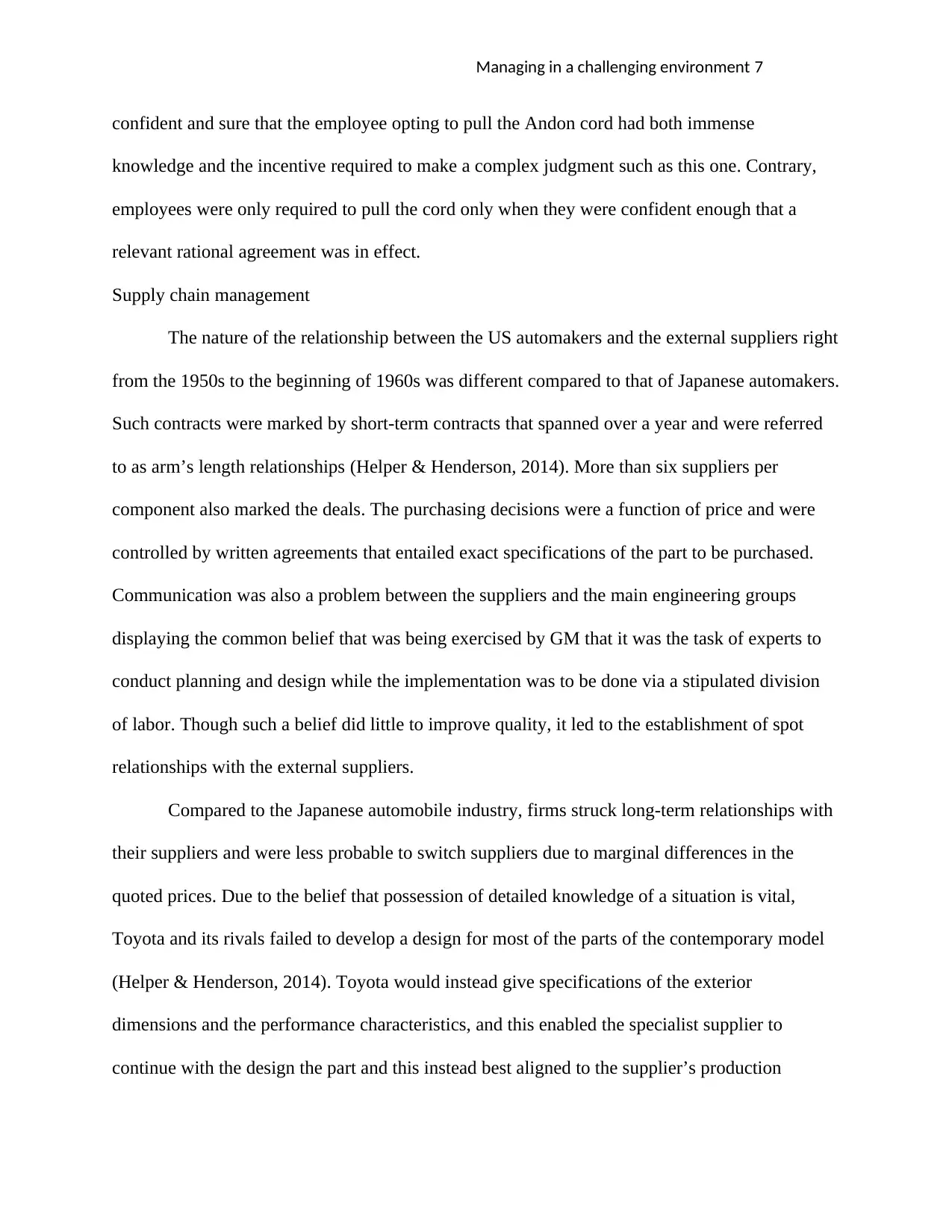
Managing in a challenging environment 7
confident and sure that the employee opting to pull the Andon cord had both immense
knowledge and the incentive required to make a complex judgment such as this one. Contrary,
employees were only required to pull the cord only when they were confident enough that a
relevant rational agreement was in effect.
Supply chain management
The nature of the relationship between the US automakers and the external suppliers right
from the 1950s to the beginning of 1960s was different compared to that of Japanese automakers.
Such contracts were marked by short-term contracts that spanned over a year and were referred
to as arm’s length relationships (Helper & Henderson, 2014). More than six suppliers per
component also marked the deals. The purchasing decisions were a function of price and were
controlled by written agreements that entailed exact specifications of the part to be purchased.
Communication was also a problem between the suppliers and the main engineering groups
displaying the common belief that was being exercised by GM that it was the task of experts to
conduct planning and design while the implementation was to be done via a stipulated division
of labor. Though such a belief did little to improve quality, it led to the establishment of spot
relationships with the external suppliers.
Compared to the Japanese automobile industry, firms struck long-term relationships with
their suppliers and were less probable to switch suppliers due to marginal differences in the
quoted prices. Due to the belief that possession of detailed knowledge of a situation is vital,
Toyota and its rivals failed to develop a design for most of the parts of the contemporary model
(Helper & Henderson, 2014). Toyota would instead give specifications of the exterior
dimensions and the performance characteristics, and this enabled the specialist supplier to
continue with the design the part and this instead best aligned to the supplier’s production
confident and sure that the employee opting to pull the Andon cord had both immense
knowledge and the incentive required to make a complex judgment such as this one. Contrary,
employees were only required to pull the cord only when they were confident enough that a
relevant rational agreement was in effect.
Supply chain management
The nature of the relationship between the US automakers and the external suppliers right
from the 1950s to the beginning of 1960s was different compared to that of Japanese automakers.
Such contracts were marked by short-term contracts that spanned over a year and were referred
to as arm’s length relationships (Helper & Henderson, 2014). More than six suppliers per
component also marked the deals. The purchasing decisions were a function of price and were
controlled by written agreements that entailed exact specifications of the part to be purchased.
Communication was also a problem between the suppliers and the main engineering groups
displaying the common belief that was being exercised by GM that it was the task of experts to
conduct planning and design while the implementation was to be done via a stipulated division
of labor. Though such a belief did little to improve quality, it led to the establishment of spot
relationships with the external suppliers.
Compared to the Japanese automobile industry, firms struck long-term relationships with
their suppliers and were less probable to switch suppliers due to marginal differences in the
quoted prices. Due to the belief that possession of detailed knowledge of a situation is vital,
Toyota and its rivals failed to develop a design for most of the parts of the contemporary model
(Helper & Henderson, 2014). Toyota would instead give specifications of the exterior
dimensions and the performance characteristics, and this enabled the specialist supplier to
continue with the design the part and this instead best aligned to the supplier’s production
Paraphrase This Document
Need a fresh take? Get an instant paraphrase of this document with our AI Paraphraser
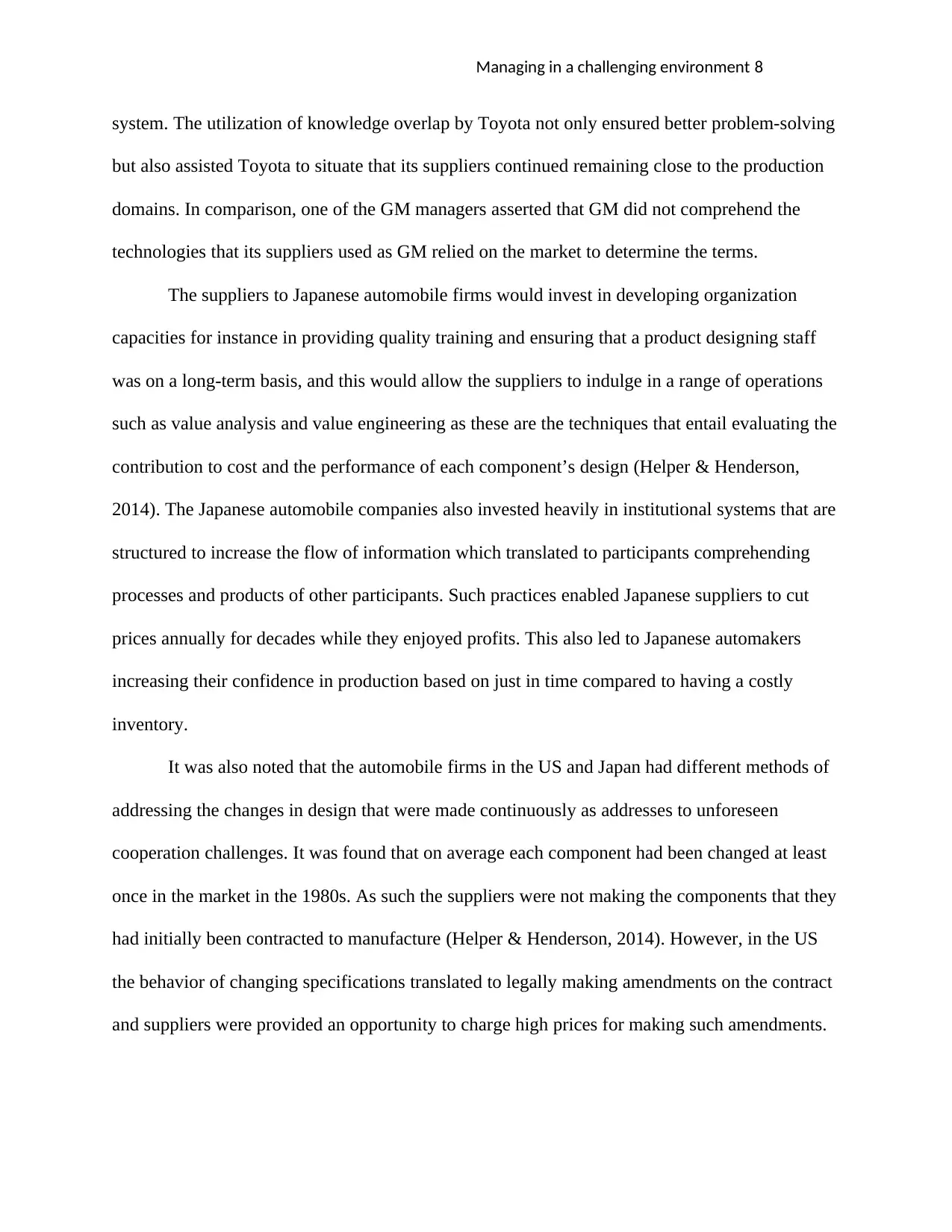
Managing in a challenging environment 8
system. The utilization of knowledge overlap by Toyota not only ensured better problem-solving
but also assisted Toyota to situate that its suppliers continued remaining close to the production
domains. In comparison, one of the GM managers asserted that GM did not comprehend the
technologies that its suppliers used as GM relied on the market to determine the terms.
The suppliers to Japanese automobile firms would invest in developing organization
capacities for instance in providing quality training and ensuring that a product designing staff
was on a long-term basis, and this would allow the suppliers to indulge in a range of operations
such as value analysis and value engineering as these are the techniques that entail evaluating the
contribution to cost and the performance of each component’s design (Helper & Henderson,
2014). The Japanese automobile companies also invested heavily in institutional systems that are
structured to increase the flow of information which translated to participants comprehending
processes and products of other participants. Such practices enabled Japanese suppliers to cut
prices annually for decades while they enjoyed profits. This also led to Japanese automakers
increasing their confidence in production based on just in time compared to having a costly
inventory.
It was also noted that the automobile firms in the US and Japan had different methods of
addressing the changes in design that were made continuously as addresses to unforeseen
cooperation challenges. It was found that on average each component had been changed at least
once in the market in the 1980s. As such the suppliers were not making the components that they
had initially been contracted to manufacture (Helper & Henderson, 2014). However, in the US
the behavior of changing specifications translated to legally making amendments on the contract
and suppliers were provided an opportunity to charge high prices for making such amendments.
system. The utilization of knowledge overlap by Toyota not only ensured better problem-solving
but also assisted Toyota to situate that its suppliers continued remaining close to the production
domains. In comparison, one of the GM managers asserted that GM did not comprehend the
technologies that its suppliers used as GM relied on the market to determine the terms.
The suppliers to Japanese automobile firms would invest in developing organization
capacities for instance in providing quality training and ensuring that a product designing staff
was on a long-term basis, and this would allow the suppliers to indulge in a range of operations
such as value analysis and value engineering as these are the techniques that entail evaluating the
contribution to cost and the performance of each component’s design (Helper & Henderson,
2014). The Japanese automobile companies also invested heavily in institutional systems that are
structured to increase the flow of information which translated to participants comprehending
processes and products of other participants. Such practices enabled Japanese suppliers to cut
prices annually for decades while they enjoyed profits. This also led to Japanese automakers
increasing their confidence in production based on just in time compared to having a costly
inventory.
It was also noted that the automobile firms in the US and Japan had different methods of
addressing the changes in design that were made continuously as addresses to unforeseen
cooperation challenges. It was found that on average each component had been changed at least
once in the market in the 1980s. As such the suppliers were not making the components that they
had initially been contracted to manufacture (Helper & Henderson, 2014). However, in the US
the behavior of changing specifications translated to legally making amendments on the contract
and suppliers were provided an opportunity to charge high prices for making such amendments.
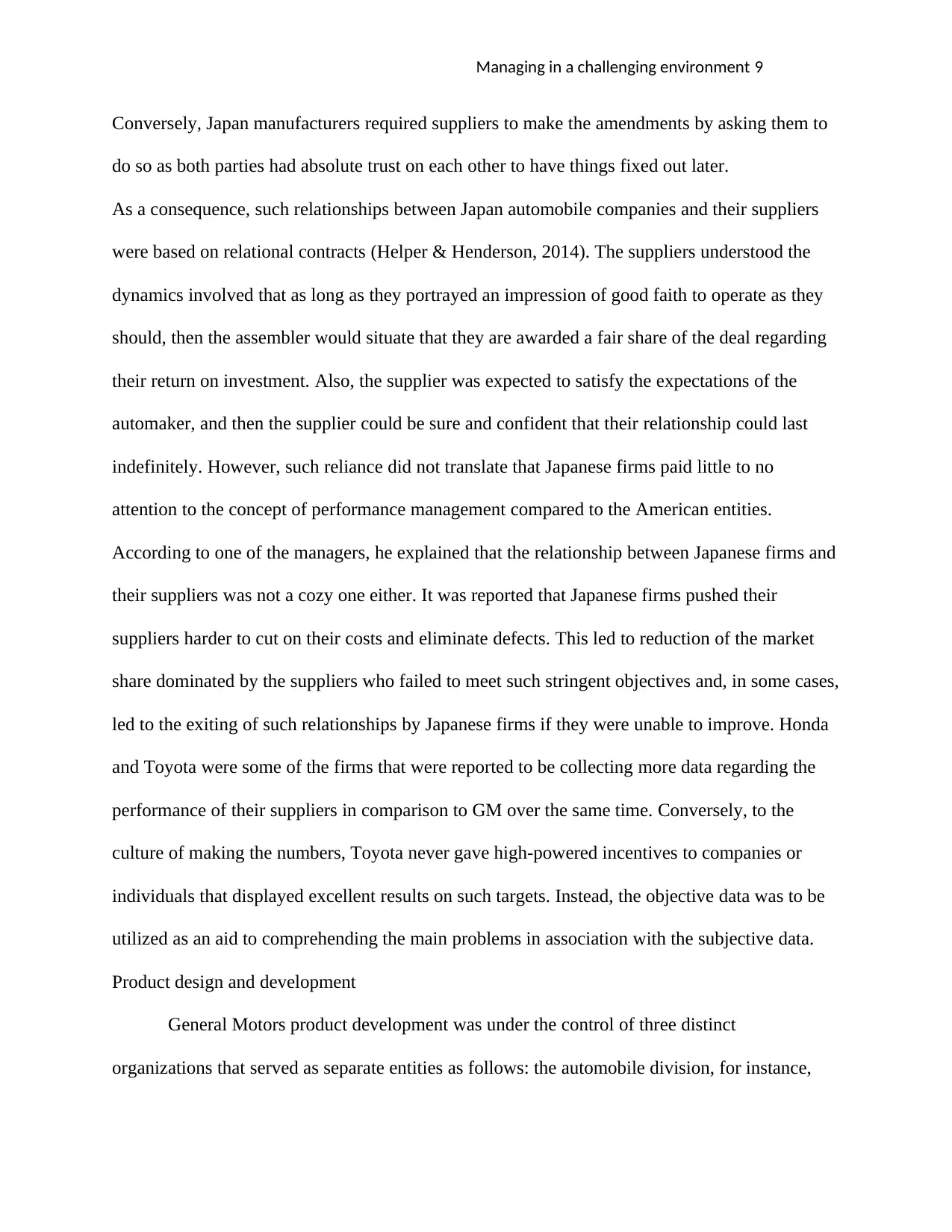
Managing in a challenging environment 9
Conversely, Japan manufacturers required suppliers to make the amendments by asking them to
do so as both parties had absolute trust on each other to have things fixed out later.
As a consequence, such relationships between Japan automobile companies and their suppliers
were based on relational contracts (Helper & Henderson, 2014). The suppliers understood the
dynamics involved that as long as they portrayed an impression of good faith to operate as they
should, then the assembler would situate that they are awarded a fair share of the deal regarding
their return on investment. Also, the supplier was expected to satisfy the expectations of the
automaker, and then the supplier could be sure and confident that their relationship could last
indefinitely. However, such reliance did not translate that Japanese firms paid little to no
attention to the concept of performance management compared to the American entities.
According to one of the managers, he explained that the relationship between Japanese firms and
their suppliers was not a cozy one either. It was reported that Japanese firms pushed their
suppliers harder to cut on their costs and eliminate defects. This led to reduction of the market
share dominated by the suppliers who failed to meet such stringent objectives and, in some cases,
led to the exiting of such relationships by Japanese firms if they were unable to improve. Honda
and Toyota were some of the firms that were reported to be collecting more data regarding the
performance of their suppliers in comparison to GM over the same time. Conversely, to the
culture of making the numbers, Toyota never gave high-powered incentives to companies or
individuals that displayed excellent results on such targets. Instead, the objective data was to be
utilized as an aid to comprehending the main problems in association with the subjective data.
Product design and development
General Motors product development was under the control of three distinct
organizations that served as separate entities as follows: the automobile division, for instance,
Conversely, Japan manufacturers required suppliers to make the amendments by asking them to
do so as both parties had absolute trust on each other to have things fixed out later.
As a consequence, such relationships between Japan automobile companies and their suppliers
were based on relational contracts (Helper & Henderson, 2014). The suppliers understood the
dynamics involved that as long as they portrayed an impression of good faith to operate as they
should, then the assembler would situate that they are awarded a fair share of the deal regarding
their return on investment. Also, the supplier was expected to satisfy the expectations of the
automaker, and then the supplier could be sure and confident that their relationship could last
indefinitely. However, such reliance did not translate that Japanese firms paid little to no
attention to the concept of performance management compared to the American entities.
According to one of the managers, he explained that the relationship between Japanese firms and
their suppliers was not a cozy one either. It was reported that Japanese firms pushed their
suppliers harder to cut on their costs and eliminate defects. This led to reduction of the market
share dominated by the suppliers who failed to meet such stringent objectives and, in some cases,
led to the exiting of such relationships by Japanese firms if they were unable to improve. Honda
and Toyota were some of the firms that were reported to be collecting more data regarding the
performance of their suppliers in comparison to GM over the same time. Conversely, to the
culture of making the numbers, Toyota never gave high-powered incentives to companies or
individuals that displayed excellent results on such targets. Instead, the objective data was to be
utilized as an aid to comprehending the main problems in association with the subjective data.
Product design and development
General Motors product development was under the control of three distinct
organizations that served as separate entities as follows: the automobile division, for instance,
⊘ This is a preview!⊘
Do you want full access?
Subscribe today to unlock all pages.

Trusted by 1+ million students worldwide
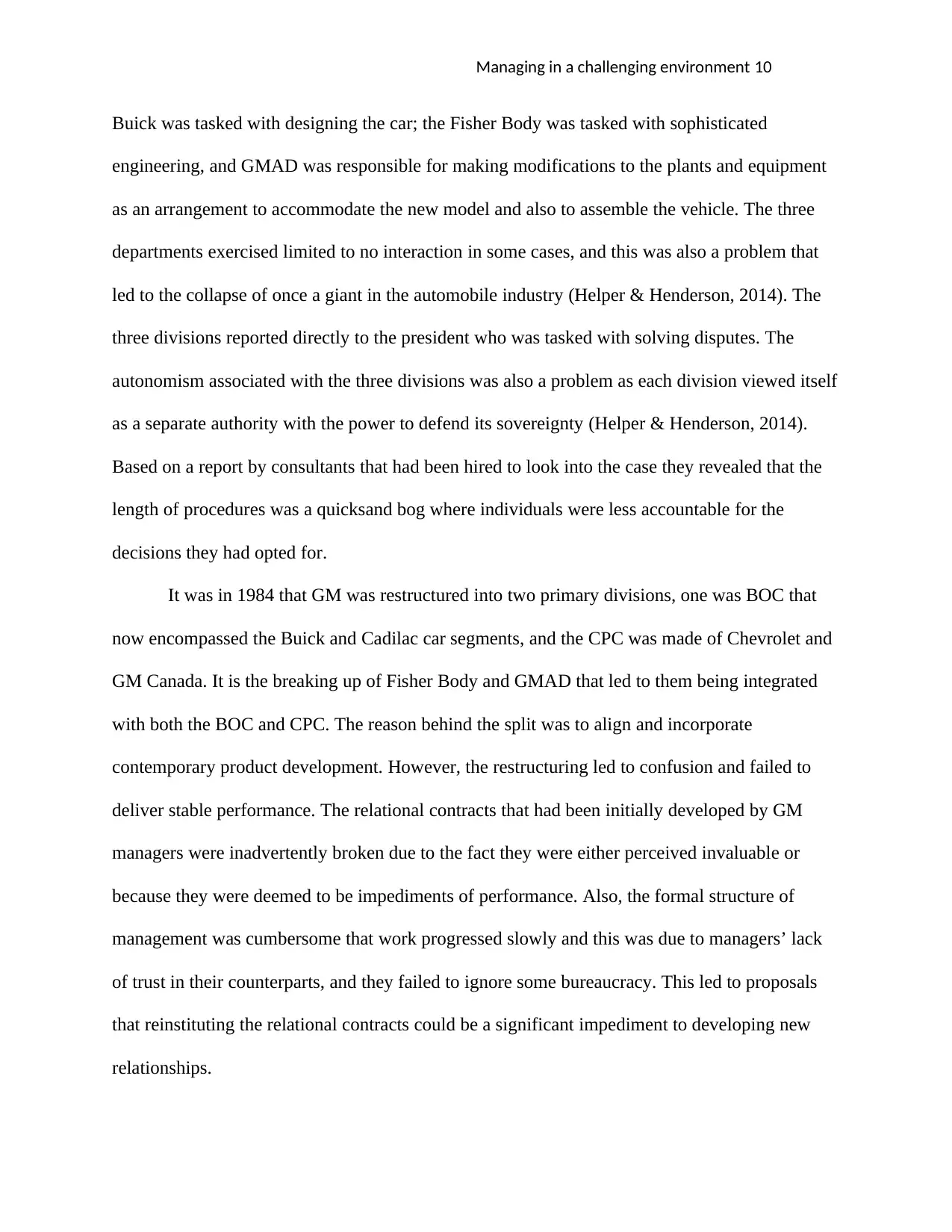
Managing in a challenging environment 10
Buick was tasked with designing the car; the Fisher Body was tasked with sophisticated
engineering, and GMAD was responsible for making modifications to the plants and equipment
as an arrangement to accommodate the new model and also to assemble the vehicle. The three
departments exercised limited to no interaction in some cases, and this was also a problem that
led to the collapse of once a giant in the automobile industry (Helper & Henderson, 2014). The
three divisions reported directly to the president who was tasked with solving disputes. The
autonomism associated with the three divisions was also a problem as each division viewed itself
as a separate authority with the power to defend its sovereignty (Helper & Henderson, 2014).
Based on a report by consultants that had been hired to look into the case they revealed that the
length of procedures was a quicksand bog where individuals were less accountable for the
decisions they had opted for.
It was in 1984 that GM was restructured into two primary divisions, one was BOC that
now encompassed the Buick and Cadilac car segments, and the CPC was made of Chevrolet and
GM Canada. It is the breaking up of Fisher Body and GMAD that led to them being integrated
with both the BOC and CPC. The reason behind the split was to align and incorporate
contemporary product development. However, the restructuring led to confusion and failed to
deliver stable performance. The relational contracts that had been initially developed by GM
managers were inadvertently broken due to the fact they were either perceived invaluable or
because they were deemed to be impediments of performance. Also, the formal structure of
management was cumbersome that work progressed slowly and this was due to managers’ lack
of trust in their counterparts, and they failed to ignore some bureaucracy. This led to proposals
that reinstituting the relational contracts could be a significant impediment to developing new
relationships.
Buick was tasked with designing the car; the Fisher Body was tasked with sophisticated
engineering, and GMAD was responsible for making modifications to the plants and equipment
as an arrangement to accommodate the new model and also to assemble the vehicle. The three
departments exercised limited to no interaction in some cases, and this was also a problem that
led to the collapse of once a giant in the automobile industry (Helper & Henderson, 2014). The
three divisions reported directly to the president who was tasked with solving disputes. The
autonomism associated with the three divisions was also a problem as each division viewed itself
as a separate authority with the power to defend its sovereignty (Helper & Henderson, 2014).
Based on a report by consultants that had been hired to look into the case they revealed that the
length of procedures was a quicksand bog where individuals were less accountable for the
decisions they had opted for.
It was in 1984 that GM was restructured into two primary divisions, one was BOC that
now encompassed the Buick and Cadilac car segments, and the CPC was made of Chevrolet and
GM Canada. It is the breaking up of Fisher Body and GMAD that led to them being integrated
with both the BOC and CPC. The reason behind the split was to align and incorporate
contemporary product development. However, the restructuring led to confusion and failed to
deliver stable performance. The relational contracts that had been initially developed by GM
managers were inadvertently broken due to the fact they were either perceived invaluable or
because they were deemed to be impediments of performance. Also, the formal structure of
management was cumbersome that work progressed slowly and this was due to managers’ lack
of trust in their counterparts, and they failed to ignore some bureaucracy. This led to proposals
that reinstituting the relational contracts could be a significant impediment to developing new
relationships.
Paraphrase This Document
Need a fresh take? Get an instant paraphrase of this document with our AI Paraphraser
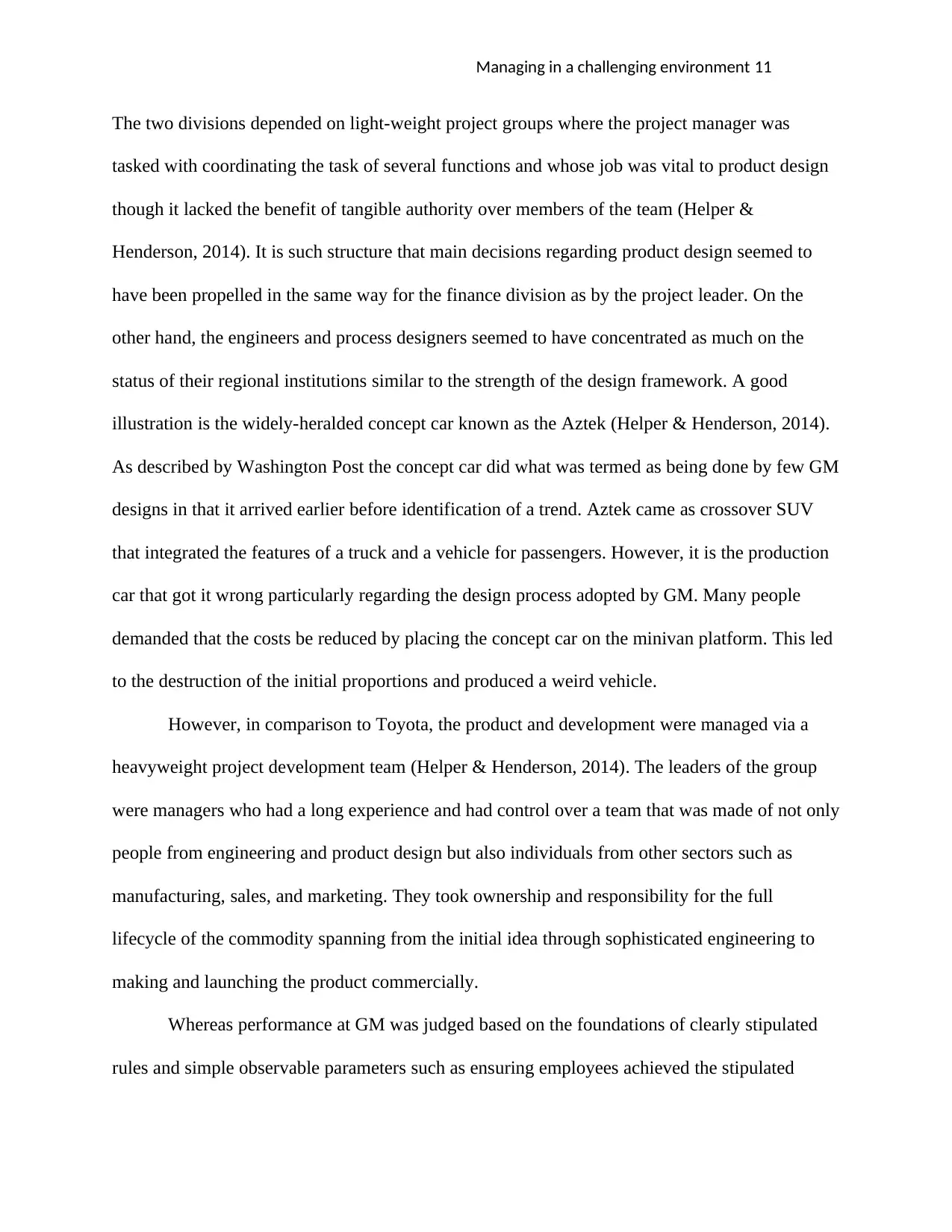
Managing in a challenging environment 11
The two divisions depended on light-weight project groups where the project manager was
tasked with coordinating the task of several functions and whose job was vital to product design
though it lacked the benefit of tangible authority over members of the team (Helper &
Henderson, 2014). It is such structure that main decisions regarding product design seemed to
have been propelled in the same way for the finance division as by the project leader. On the
other hand, the engineers and process designers seemed to have concentrated as much on the
status of their regional institutions similar to the strength of the design framework. A good
illustration is the widely-heralded concept car known as the Aztek (Helper & Henderson, 2014).
As described by Washington Post the concept car did what was termed as being done by few GM
designs in that it arrived earlier before identification of a trend. Aztek came as crossover SUV
that integrated the features of a truck and a vehicle for passengers. However, it is the production
car that got it wrong particularly regarding the design process adopted by GM. Many people
demanded that the costs be reduced by placing the concept car on the minivan platform. This led
to the destruction of the initial proportions and produced a weird vehicle.
However, in comparison to Toyota, the product and development were managed via a
heavyweight project development team (Helper & Henderson, 2014). The leaders of the group
were managers who had a long experience and had control over a team that was made of not only
people from engineering and product design but also individuals from other sectors such as
manufacturing, sales, and marketing. They took ownership and responsibility for the full
lifecycle of the commodity spanning from the initial idea through sophisticated engineering to
making and launching the product commercially.
Whereas performance at GM was judged based on the foundations of clearly stipulated
rules and simple observable parameters such as ensuring employees achieved the stipulated
The two divisions depended on light-weight project groups where the project manager was
tasked with coordinating the task of several functions and whose job was vital to product design
though it lacked the benefit of tangible authority over members of the team (Helper &
Henderson, 2014). It is such structure that main decisions regarding product design seemed to
have been propelled in the same way for the finance division as by the project leader. On the
other hand, the engineers and process designers seemed to have concentrated as much on the
status of their regional institutions similar to the strength of the design framework. A good
illustration is the widely-heralded concept car known as the Aztek (Helper & Henderson, 2014).
As described by Washington Post the concept car did what was termed as being done by few GM
designs in that it arrived earlier before identification of a trend. Aztek came as crossover SUV
that integrated the features of a truck and a vehicle for passengers. However, it is the production
car that got it wrong particularly regarding the design process adopted by GM. Many people
demanded that the costs be reduced by placing the concept car on the minivan platform. This led
to the destruction of the initial proportions and produced a weird vehicle.
However, in comparison to Toyota, the product and development were managed via a
heavyweight project development team (Helper & Henderson, 2014). The leaders of the group
were managers who had a long experience and had control over a team that was made of not only
people from engineering and product design but also individuals from other sectors such as
manufacturing, sales, and marketing. They took ownership and responsibility for the full
lifecycle of the commodity spanning from the initial idea through sophisticated engineering to
making and launching the product commercially.
Whereas performance at GM was judged based on the foundations of clearly stipulated
rules and simple observable parameters such as ensuring employees achieved the stipulated
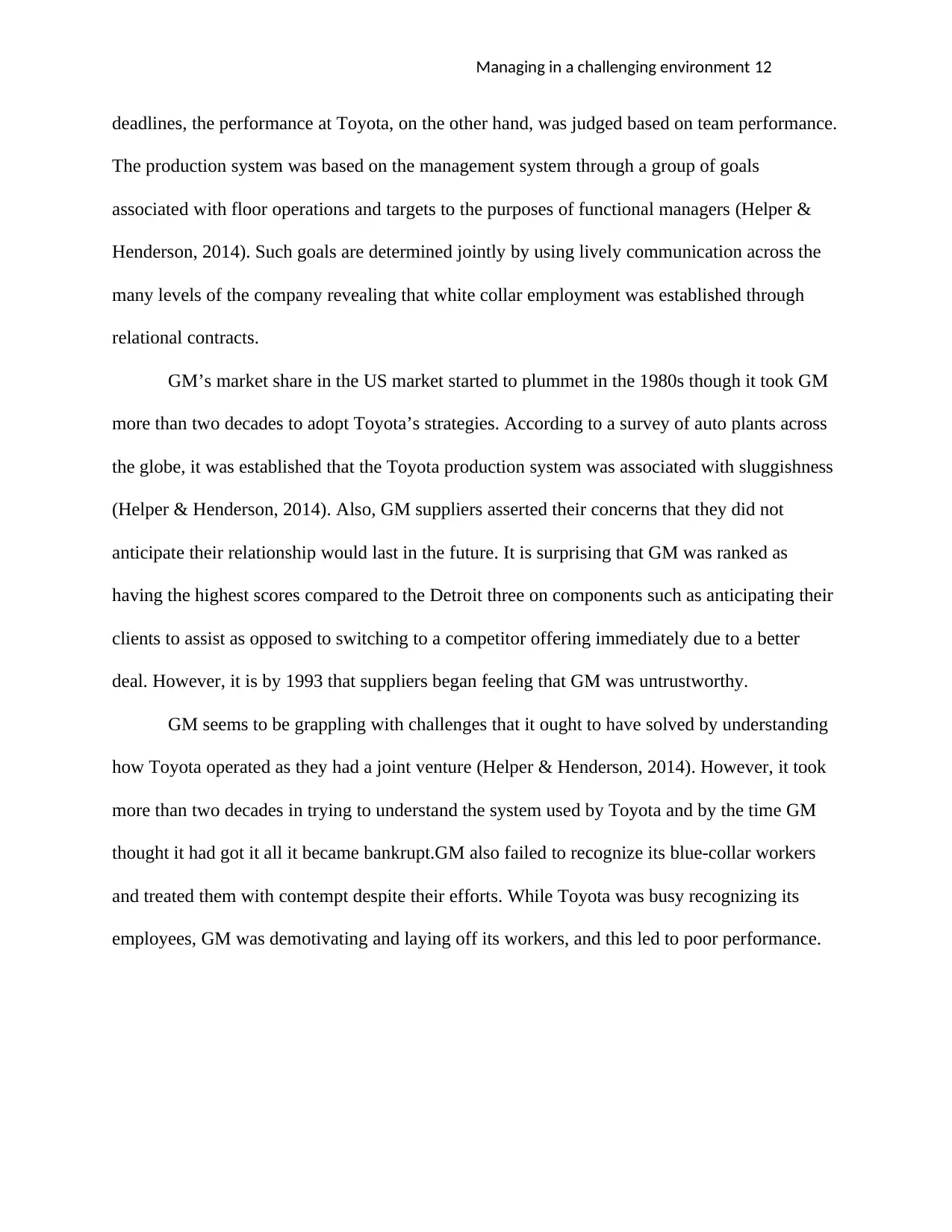
Managing in a challenging environment 12
deadlines, the performance at Toyota, on the other hand, was judged based on team performance.
The production system was based on the management system through a group of goals
associated with floor operations and targets to the purposes of functional managers (Helper &
Henderson, 2014). Such goals are determined jointly by using lively communication across the
many levels of the company revealing that white collar employment was established through
relational contracts.
GM’s market share in the US market started to plummet in the 1980s though it took GM
more than two decades to adopt Toyota’s strategies. According to a survey of auto plants across
the globe, it was established that the Toyota production system was associated with sluggishness
(Helper & Henderson, 2014). Also, GM suppliers asserted their concerns that they did not
anticipate their relationship would last in the future. It is surprising that GM was ranked as
having the highest scores compared to the Detroit three on components such as anticipating their
clients to assist as opposed to switching to a competitor offering immediately due to a better
deal. However, it is by 1993 that suppliers began feeling that GM was untrustworthy.
GM seems to be grappling with challenges that it ought to have solved by understanding
how Toyota operated as they had a joint venture (Helper & Henderson, 2014). However, it took
more than two decades in trying to understand the system used by Toyota and by the time GM
thought it had got it all it became bankrupt.GM also failed to recognize its blue-collar workers
and treated them with contempt despite their efforts. While Toyota was busy recognizing its
employees, GM was demotivating and laying off its workers, and this led to poor performance.
deadlines, the performance at Toyota, on the other hand, was judged based on team performance.
The production system was based on the management system through a group of goals
associated with floor operations and targets to the purposes of functional managers (Helper &
Henderson, 2014). Such goals are determined jointly by using lively communication across the
many levels of the company revealing that white collar employment was established through
relational contracts.
GM’s market share in the US market started to plummet in the 1980s though it took GM
more than two decades to adopt Toyota’s strategies. According to a survey of auto plants across
the globe, it was established that the Toyota production system was associated with sluggishness
(Helper & Henderson, 2014). Also, GM suppliers asserted their concerns that they did not
anticipate their relationship would last in the future. It is surprising that GM was ranked as
having the highest scores compared to the Detroit three on components such as anticipating their
clients to assist as opposed to switching to a competitor offering immediately due to a better
deal. However, it is by 1993 that suppliers began feeling that GM was untrustworthy.
GM seems to be grappling with challenges that it ought to have solved by understanding
how Toyota operated as they had a joint venture (Helper & Henderson, 2014). However, it took
more than two decades in trying to understand the system used by Toyota and by the time GM
thought it had got it all it became bankrupt.GM also failed to recognize its blue-collar workers
and treated them with contempt despite their efforts. While Toyota was busy recognizing its
employees, GM was demotivating and laying off its workers, and this led to poor performance.
⊘ This is a preview!⊘
Do you want full access?
Subscribe today to unlock all pages.

Trusted by 1+ million students worldwide
1 out of 13
Your All-in-One AI-Powered Toolkit for Academic Success.
+13062052269
info@desklib.com
Available 24*7 on WhatsApp / Email
![[object Object]](/_next/static/media/star-bottom.7253800d.svg)
Unlock your academic potential
Copyright © 2020–2025 A2Z Services. All Rights Reserved. Developed and managed by ZUCOL.